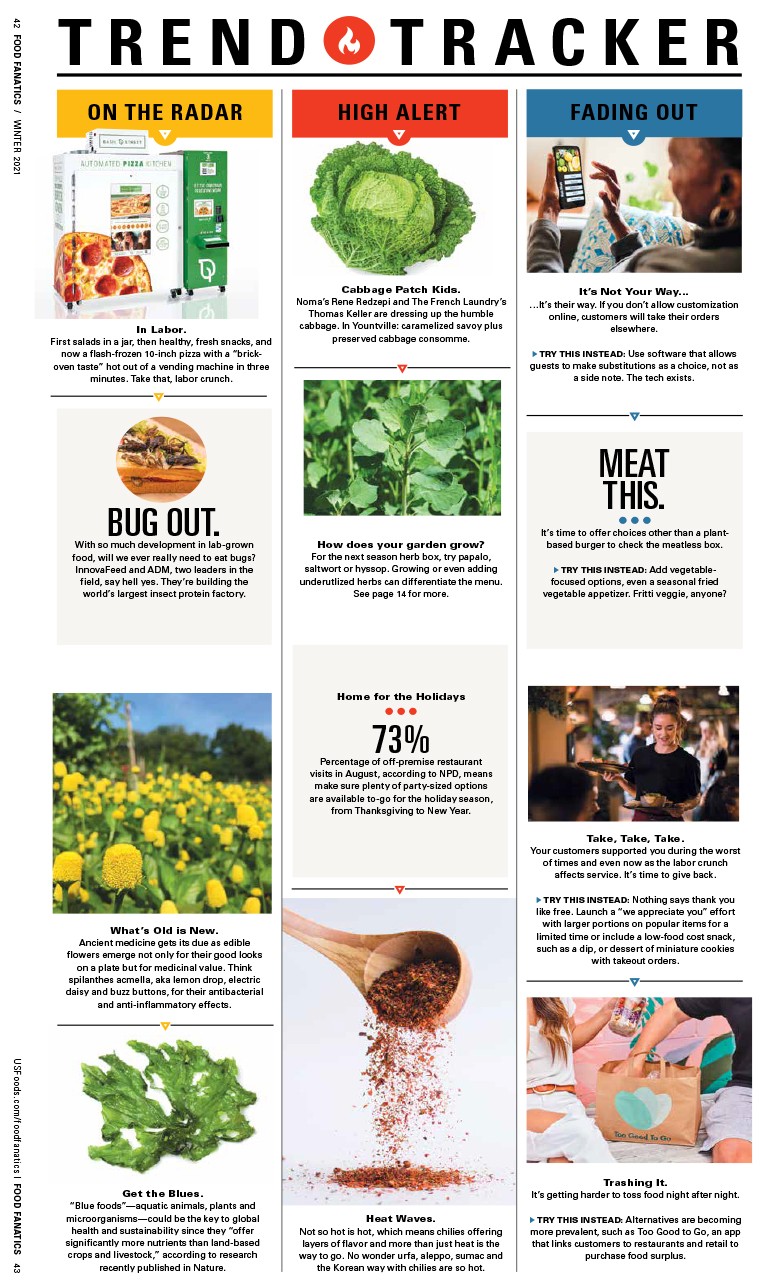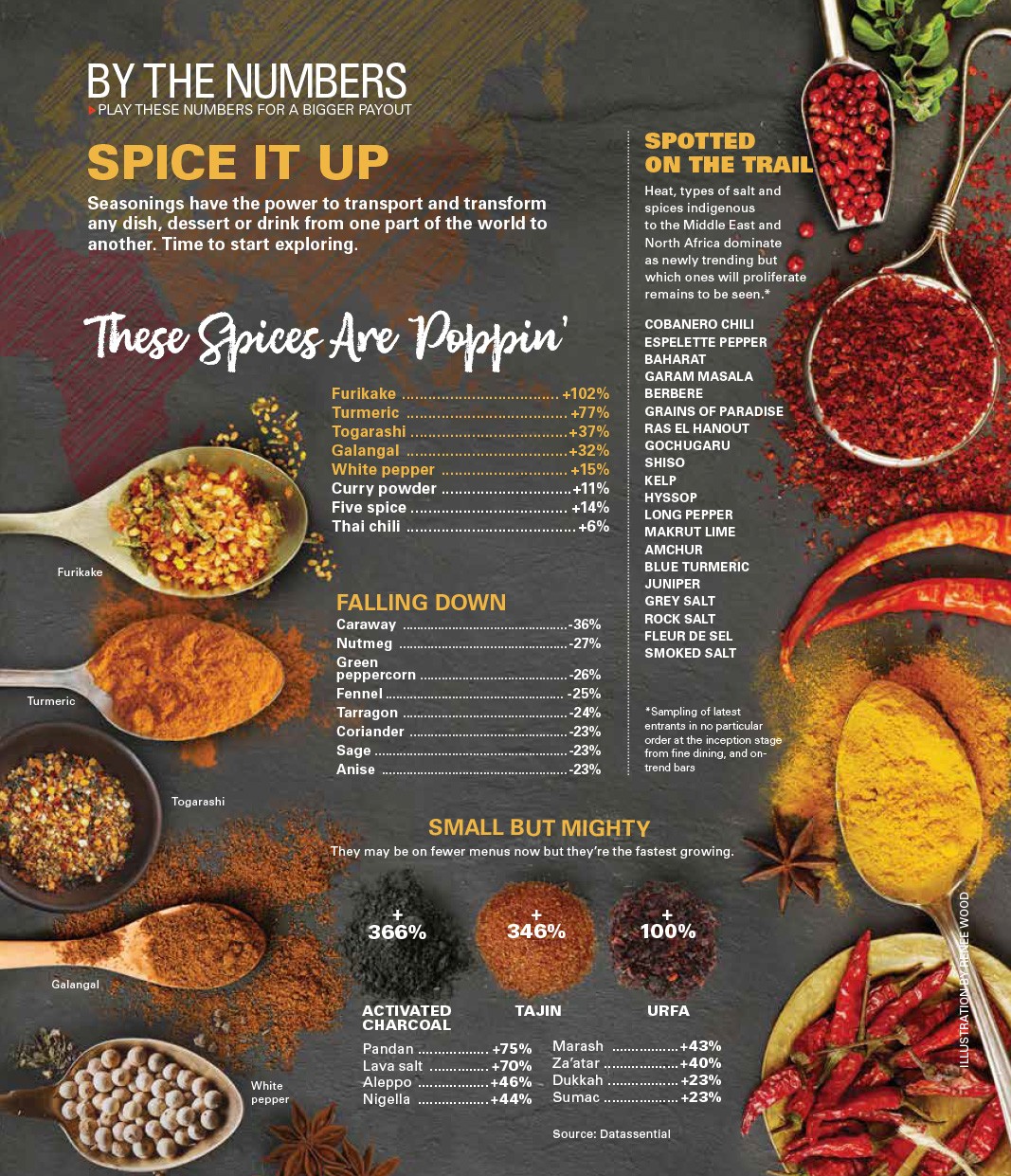LOADED HOT DOG IDEAS TO BOOST YOUR MENU
Let’s be frank: your menu needs a hot dog. But not just any dog—it’s got to be a real showboat.
Slathered with slaw, topped with togarashi (Japanese spice blend) or buried under mac ‘n cheese, hot dogs don’t have to be ketchup and mustard basics. If your red hots are good enough, a single-concept hot dog stand could build a cult following. Just ask the guys at Hot Doug’s in Chicago or Pink’s in Los Angeles, who have lines around the corner daily – and even a few fans with tattoos of their logos.
The main fixture at ballparks and summer cookouts has become a staple on 20 percent of menus across the country, according to research firm Datassential. That figure has been constant for the past eight years, though the climate is changing. Haute dogs are spilling into white tablecloth territory. Five percent of fine dining restaurants serve decked-out dogs for an average price of $16.
Want to run with the big dogs? Get crazy with condiments and see how your sales stack up.
LOAD HOT DOGS WITH NEW TOPPINGS
A top- or side-loading bun ready to be stuffed with meat and toppings is a blank canvas for mad scientist levels of Frankendog experimentation. It’s not terribly risky to top an inexpensive hot dog with grilled pineapple, various hot chiles or pasta. Regular dogs cost about 25 cents each, and you can assume another 50 cents for the bun and condiments. A 75-cent investment on a product that rarely sells for under $4 is not too shabby. If the experiment fails, toss the dog and try other combinations.
One-of-a-kind condiments made in-house can help differentiate a hot dog from its competitors. But costs can add up quickly, particularly with perishable ingredients. “Guacamole and tomatoes are our most expensive condiments to store and use on hot dogs,” says Richard Pink, of Pink’s.
That said, a clever operator can always find ways to minimize the cost of premium ingredients. Randy Walters, owner of Pittsburgh Willy’s in Chandler, Ariz., shops daily for his unique condiments, which provides creativity and buying power. “I take advantage of specials and maintain freshness of perishable condiments,” he says. “My desire to develop and offer unique condiments from the start of my business led to huge success.”
POPULAR HOT DOG TOPPINGS
Loaded dogs are often the best performers, such as the chili cheese dog with mustard, onions, chili and American cheese ($3.90) at Pink’s, which makes up 40 percent of total hot dog sales. Its popularity isn’t surprising, as a 2013 Datassential report ranked chili, cheese, onion and mustard as the most popular condiments, while barbecue sauce, bacon and relish are showing the most growth.
Specialty toppings can turn hot dogs into a spectacle. At Susie’s in Chicago, the Pizza Dog ($3.73) is a massive mound of mozzarella, sweet marinara sauce, onions and green peppers atop a wiener. Steve’s Hot Dogs on the Hill in St. Louis offers the Backyard BBQ Dog ($6.99), reminiscent of a complete barbecue dinner with tangy sauce, potato salad and baked beans.
Regional specialties tend to have a devout following. Once sold almost exclusively from street carts, Sonoran hot dogs (wieners wrapped in bacon and sometimes served with beans, salsa and cream sauce) are showing up across the country at places like Tortaria in New York, Big Star in Chicago and Xico in Portland, Ore. Neon green relish is a staple for any Chicago-style hot dog, but Gene & Jude’s in River Grove, Ill., opts for a less glowing sweet relish for its minimalist Chicago-style dog ($2.71), which comes with onions, mustard, sport peppers and hand-cut fries.
Walters says specialty condiments are the driving force of success at Pittsburgh Willy’s. “Every day that I feature a special gourmet hot dog on Facebook, it becomes our best-seller for that day,” he says. “In most cases, you can’t see the hot dog; you see the condiments. It is the condiments that bring people in.”
"In most cases, you can’t see the hot dog; you see the condiments. It is the condiments that bring people in."
-Randy Walters, owner of Pittsburgh Willy's
DOES HOT DOG MEAT MATTER?
With all those condiments, it might seem that the namesake sausage takes second place to toppings. That’s not so, Pink says.
“Customers still judge the quality of the hot dog, no matter how many toppings are layered on,” he says.
Serving housemade dogs may be fine for a small hot dog stand, but not a high-volume operation, Pink says. “In order to meet demand, it may be necessary for the owner to open a factory, which is very expensive,” he adds. “The key is whether the owner can generate enough customer demand to justify the capital investment.” That doesn’t mean the hot dog must be handcrafted. “We don’t make our own hot dogs,” says Doug Sohn of Hot Doug’s. “Vienna [Beef] does a way better job than I do.”
THE RIGHT TEXTURE FOR LOADED HOT DOGS
Texture is just as important as flavor when it comes to hot dogs, particularly the slight “snap” when the bite breaks the casing.
Considering the number of snap loyalists, it might be surprising that the majority of hot dogs are skinless, according to the National Hot Dog & Sausage Council. These skinless dogs are cooked inside a cellulose casing which is removed prior to packaging.
The snap is one of the defining characteristics of the hot dogs at Hot Doug’s and Pink’s. “The natural casing holds in the juices of the hot dog – so when you bite into it, the flavors of the spices in the hot dog flow onto the taste buds, and allow the full flavor of the hot dog to be enjoyed,” Pink says.
Snap or skinless, a winning wiener is built on balance. “You can put fun things on a hot dog,” says Chris Koetke, vice president of Kendall College School of Culinary Arts in Chicago, “but at some point, it becomes oppressive, and you lose the essence of the hot dog.”
NEW HOT DOG TOPPING IDEASAre these wiener renditions intriguing or disgusting? You decide. Slaw dog: Creamy slaw is a revered condiment in the South, where it’s piled on thick, like at Hillbilly Hot Dogs in Lesage, W.Va. Reuben dog: Greatest American Hot Dogs in Gaithersburg, Md., pairs a split chargrilled beef dog with corned beef, sauerkraut, Swiss cheese and a hot “angry sauce” ($6.50). Croque Madame dog: Senate in Cincinnati serves a beef hot dog with béchamel, Black Forest ham and an egg on brioche ($10). Elvis dog: The Hosmer Hound Dog at the Red Hot in Tacoma, Wash., pays homage to Elvis, dressed with peanut butter and bacon ($4). Mac ‘n cheese dog: Ditch Plains in New York ladles on this kid favorite ($16). Bento dog: Los Angeles food truck Dogzilla tops a dog with grilled onions, avocado, Japanese mayo, housemade teriyaki sauce, furikake (Japanese rice seasoning) and bacon ($6.50). |
HOT DOG SCIENCE
Many urban legends surround the “mystery meat” inside a hot dog, but Koetke says rumormongers couldn’t be further from the truth.
The science behind a hot dog is basically “making emulsified sausage. You’re creating something like a mousseline. The difference is you don’t use the heavy cream. Instead, a solid fat—could be pork or beef fat, depending on the hot dog—is cut or emulsified into a strong protein structure,” he says.
“You take very cold raw meat and grind it to a paste with ice, salt and flavorings. This develops elasticity, but because it’s protein, ice and salt, you get elastic meat. Then you add fat. Hot dogs have to have a casing. Natural casings like sheep are very delicate and have that pop or a snap.”
HOT DOG MENU STATISTICS30 Percentage of menus with hot dogs that include chili 77 Percentage of hot dogs labeled as entrées 16 Percentage of hot dogs that appear on kids menus $5.53 Average price of a hot dog Source: Food Genius and Datassential Menu Trends 2013 |
David Hammond, a founder and moderator of the culinary chat site LTHForum.com, is a corporate communications consultant and a food and travel journalist.



